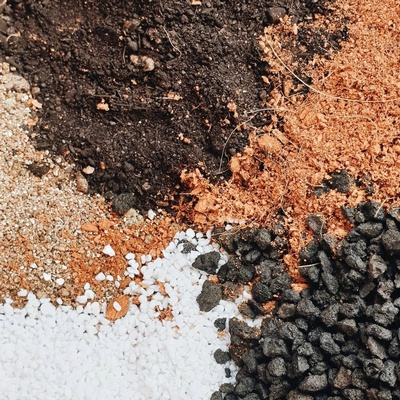Advanced Plant Care: Understanding Soil Health

Image by @mon.cotyledon
We often think that plant health is synonymous with how much water, light, and fertilizer we provide to our plants. We understand that plants have different soil requirements and some are happy growing in moss, leca, and even water. But for plants that commonly grow in soil, what does it mean to encourage and promote soil health? We’ve learned it can make a huge difference in your plants’ vitality and overall well being. Soil as a topic can be a little bland, but trust that it matters. We'll keep it brief and informative!
Understanding Soil Structure
Indoor plants need a growing medium with adequate moisture holding, and draining properties. That’s why soilless mixtures typically contain peat moss, vermiculite, sand, and perlite to provide sufficient soil aeration and adequate drainage. This type of growing medium is usually light brown in colour and and sterile, as it relies on fertilizer to be added to the soil to provide nutrients to the plant. A soil mixture, however, includes organic material to help increase moisture holding capacity. It is identified by its dark brown colour, usually containing worm castings or aged compost that provide nutrients to the plant. It is important to note that if the organic material is not properly regulated, it can add unwanted pathogens and sometimes pests to the soil. This is the reason why as plant owners we have to know what are suitable soil amendments, so that our plants remain healthy and happy!
Living Soil
Soil is naturally meant to be alive with microorganisms, bacteria, and fungi. It’s the life-stuff that a plant needs to absorb sufficient nutrients, combat pests and disease, and grow vigorously. It's the microbial activity in soil that actually helps break down and remove toxins from the air. It’s now a common practice to include mycorrhizae, a type of fungus in potting soil for its many benefits. Mycorrhizae have a symbiotic relationship with your plants. They attach themselves to the roots and help source water and make nutrients more easily available to your plant. In exchange, they take a small amount of sugars that the roots release. They help form a more fibrous root system, enabling your plant to retain more moisture, so that you do not need to water as often. Your plant in turn becomes stronger and more established.

Image by @biosnutrients
The same way that our gut health is determined by the good bacteria in our bodies, the bacteria and fungi present in the soil for our plants have a similar effect. Bacilus thuringiensis or Bt, is naturally found in soil and aids in protecting your plant from pests. This bacteria is also found on plants’ roots and releases a protein that’s toxic to larvae in the soil. If you have ever had a fungus gnat problem, Bt is an excellent and organic addition to your pest control regimen.
We are starting to see more products on the market that offer organic soil amendments that are beneficial to houseplant care. Things like worm castings sold separate to potting soil, living soil mixtures and soil drenches with active bacteria present, help aid your plants’ health in more naturally occurring ways. We try our best to mimic the environment in which our plants’ exist in the outside world. With plants having so many differing requirements regarding nutrients and soil needs, please feel free to ask any questions at the shop or email us for more info.